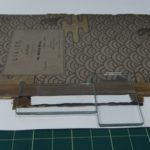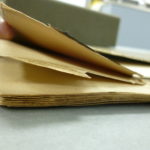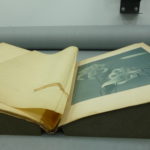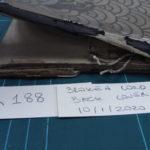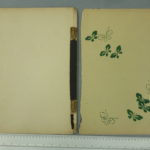Conservation: Ogawa photography meets biochemistry (2021)
We employed Lara Speroni, archives and books conservator (ACR), in December 2019 to conserve two volumes of collotypes by celebrated Japanese photographer, Kasumasa Ogawa. The plan was that the conservation work would dovetail around the loan of pages from these albums to Dulwich Picture Gallery’s exhibition, Unearthed: Photography’s Roots.
A Conservation Challenge
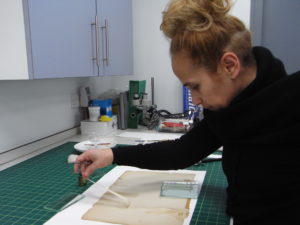 Lara’s brief was to conserve and stabilize the two collotype albums Lilies of Japan and Chrysanthemums of Japan. She would take them apart, then repair cover and page damage. She would then re-bind them in their original format using suitable conservation standard materials and techniques.
Lara’s brief was to conserve and stabilize the two collotype albums Lilies of Japan and Chrysanthemums of Japan. She would take them apart, then repair cover and page damage. She would then re-bind them in their original format using suitable conservation standard materials and techniques.
The popularity of the albums with the Silver Studio‘s designers and then students and researchers over time meant that they had become progressively weaker. They had been repaired multiple times using methods and materials that were to hand at the time. The tapes and adhesives used had created further damage. This restricted the movement of the volumes and spoiled their appearance. They also hid the delicate Japanese binding and limited its functionality.
In different combinations and amounts, bookbinding cloths (red and white), black paper, brown gummed tape and pressure sensitive tape had been used. These, in addition to gelatine or starch paste, formed the many layers of repairs found mainly along the spine and over the sewing in both albums.
Inside the albums, traditional library repairs, sellotape repairs and brown tapes had caused distortion, tearing and losses to the paper pages as well as irreversible stains.
- removal of black adhesive tape
- Lara at work
- detail of pages
- historic repairs
- detail of binding
- inside cover showing old adhesive tape
When these kind of tapes need to be removed as part of the conservation process (and if they don’t come apart by simply peeling them off), the next step is usually to introduce moisture locally by various means so that the adhesive can be reactivated and the tape removed.
These techniques worked up to the last layer of brown gummed tape and white cloth tapes which were directly applied to the cover. Lara’s attempts to lift these risked the top most decorated layer peeling away together with the tape. She had to find an alternative solution.
Enzymes are the answer
This is where photography and art and history meet science, and in particular, biochemistry.
Lara consulted with conservators working at The National Archives, who suggested (protease) enzyme gels as a promising option. She visited the archives, taking a sample of the cover with some brown gummed tape stuck on top, to test this technique. That was in the week before we all entered lockdown, March 2020.

Enzymes catalyse – or speed up – biochemical reactions and are present in all living organisms. Proteases (which break down protein), and amylases (which break down starch) from a range of sources are most commonly used in conservation to break down old adhesives.
Colleagues at The National Archives had been researching the gel application of enzymes. The enzyme is set into an agarose gel (also known as ‘agar agar’), and then applied to the paper surface – the enzyme slowly penetrates and dissolves the glue. The process is controllable, leaves no staining, and the enzyme only affects the adhesive.
This use of enzyme gels is a relatively new area of exploration in paper conservation. The technique was applied successfully for the first time at MoDA on both albums in February 2021. Lara used a protease enzyme suspended in agarose gel, which acted speedily and efficiently to break down the animal glue adhering the heavy tapes to the covers of the albums.
The impact of Covid
We intended to loan a selection of the images to Dulwich in the spring of 2020. They would then be returned to MoDA to be photographed and rebound into their original album format in time for the start of the new academic year in autumn 2020. We were on a tight schedule…
BUT…the COVID lockdowns of 2020 & 2021 resulted in MoDA’s Ogawa images being on display in Dulwich for a short time only. Finally, this conservation work took place nearly a year later than originally planned due to the global pandemic. But we’re delighted that this project enabled us to work with colleagues at The National Archives and to contribute to shared and emerging knowledge of enzymes in conservation.
Read more about the process of Rebinding the Ogawa albums here.
Digitization
We digitized both the albums that Lara conserved and you can now see them here.
